Neuroscience For Kids
Touch Experiments

Some of these experiments require a blindfold. Keep in mind that some people do not like to be blindfolded...you could ask them to keep their eyes closed, but don't count on them having their eyes closed for a very long time.
The skin is the largest sensory organ of the body. The skin is sensitive to many different kinds of "stimuli", such as touch, pressure, and temperature. Within the skin, there are different types of "receptors" that are activated by different stimuli. When a receptor is activated, it triggers a series of nerve impulses. For a person to "feel" the stimulus, the nerve impulses must make their way up to brain.
Fine Fingers
Grades K-6
We have the ability to tell whether objects are cold, hot, smooth or rough. To demonstrate the different types of receptors in the skin, gather a number of objects that are:
- smooth (an apple)
- rough (sand paper; rock)
- cold (ice)
- warm (a sun-warmed piece of metal)
Tell someone to close their eyes (or use a blindfold) and touch the items to the person's hands or fingers. Ask them what they feel.
Sand Paper Rankings
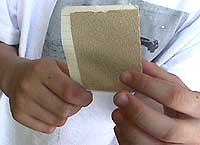
Grades K-12
To demonstrate the exquisite sensitivity of our sense of touch, try this one. Get five to 10 different grades (roughness) of sandpaper from the hardware store. The degree of roughness should be printed on the back. Cut the sandpaper into pieces about 3 in by 3 in. (If you want to get fancy, you could glue the sandpaper on to block of wood, but this is not really necessary) Make sure you write down the grade of roughness on the back of each cut piece of sandpaper! Mixup the pieces of sandpaper and place them with the rough side up. Using your (or have someone else do it) finger, line up the pieces of sandpaper in order...from the smoothest to the roughest.
Questions and Comparisons:
Check to see if you (or your test subject) did it right. Where were mistakes made? At what grade of sandpaper?
Materials:
- Sandpaper - various grades
- Wood Blocks (optional)
2-Point Discrimination
Grades 3-12
A complete LESSON PLAN with teacher and student guides is now available.

What areas of our bodies are most sensitive to touch? Hands? Feet? Fingers? To find out, perform a 2-point discrimination exam on a friend. Bend a paper clip into the shape of a U with the tips about 2 cm apart. Make sure the tips of the U are even with each other. Lightly touch the two ends of the paper clip to the back of the hand of your subject. Your subject should not look at the area of skin that is being tested. Do not press too hard! Make sure both tips touch the skin at the same time. Ask your subject if he or she felt one or two pressure points. If your subject reported one point, spread the tips of the clip a bit further apart, then touch the back of the subject's hand again. If your subject reported 2 points, push the tips a bit closer together, and test again. Measure the distance at which the subject reports "I feel two points."
Questions and Comparisons:
- Try different parts of the body: the arm, leg, fingers, back, neck, head, hand, toes.
- Compare the distances required for a "I feel 2 points" response on different body regions.
- What part of the body is most sensitive? In other words, where on the body can 2 points be detected with the smallest tip separation?
The receptors in our skin are NOT distributed in a uniform way around our bodies. Some places, such as our fingers and lips, have more touch receptors than other parts of our body, such as our backs. That's one reason why we are more sensitive to touch on our fingers and face than on our backs.
| Site | Threshold Distance |
| Fingers | 2-3 mm |
| Upper Lip | 5 mm |
| Cheek | 6 mm |
| Nose | 7 mm |
| Palm | 10 mm |
| Forehead | 15 mm |
| Foot | 20 mm |
| Belly | 30 mm |
| Forearm | 35 mm |
| Upper arm | 39 mm |
| Back | 39 mm |
| Shoulder | 41 mm |
| Thigh | 42 mm |
| Calf | 45 mm |
These data (rounded) are from a 2-pt discrimination threshold experiment (published in The Skin Senses, edited by D. R. Kenshalo, Springfield, IL, 1968).
How did your measurements compare?
Materials:
- Complete lesson plan for this experiment!
- Paper clip (or a map pin)
- Pencil and paper to track responses.
Feel It, Draw It
Grades 4-12
If you have done the 2-point discrimination experiment, you have likely seen how different parts of your body are more sensitive than other parts of your body. This is because the more sensitive areas of your body have more touch receptors than other parts of your body. Here is one more way to demonstrate this concept.
- Draw a shape or design on a piece of paper.
- Give your subject a blank piece of paper and a pencil or pen.
- Place the paper with your design on the back of your subject.
- Tell your subjects that you are going to make a few lines on the paper that they should feel.
- Using a pencil eraser or other blunt object, draw a line from your shape that is on your paper. Ask your subjects to draw the line that they feel on their back.
- Continue to draw lines from your shape; do not move the paper that is on your subject's back.
- When you are finished drawing all of the lines from your shape, compare your original shape with the drawing of your subject.
- Make shapes that you can use on the hands, legs (don't let your subjects see the design) and back.
- Make simple and more complex shapes.
Map Your Homunculus
Grades 4-12
Credit for this activity: Rebekah Corlew, Ph.D. and Theo Walker, Max Planck Florida Institute, Jupiter, FL
What would you look like if you were a homunculus? Use the results of a two-point discrimination test to find out!
Make your two point discrimination tester:
- Cut toothpicks in half.
- Glue toothpicks in pairs to index cards so that the points stick out. You should make six different testers with distances between the tips of the toothpicks of 60mm, 30mm, 15mm, 7.5mm, 3.75mm and 0mm. (The 0 mm tester can have just one toothpick). The lengths of the pointy parts should be the same for the pairs.
- As seen in the illustration below, you can use two index cards for all six testers.
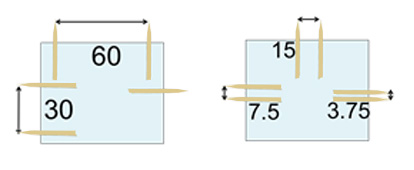
Test your subjects using two-point discrimination testers:
- The experimenter will lightly touch the two points of the tester to the subject's skin. The points must land at the same time.
- The subject will report (without looking) if there were two points or one. For a quick and easy version of the test, start with the largest distance first (60mm) and work down until the subject can no longer feel two points.
- Occasionally, touch with a single point so the subject doesn't try to fool the test.
- Test the forehead, back, arms, hands, legs, and feet. For each body part, when the subject reports one point instead of two, write down the last distance that the subject could still feel two. Then, open the "homunculus maker" and click on the avatar of your choice.
- On that page, enter your experimental data and watch your homunculus morph.
- Print it out and compare with your friends!
Materials
- Ruler with millimeter scale
- Glue or tape
- Toothpicks
- Computer with internet connection
Become a Neurologist - Detection Threshold
Grades 4-12
Become a neurologist! Make your own set of Von Frey hairs to test
detection thresholds. The tactile detection threshold is the smallest
amount of touch necessary for someone to say "Hey, I feel that." To make a
set of Von Frey hairs, get various thicknesses of monofilament FISHING
LINE from your local sporting goods shop or hardware store. That's
right...fishing line! From each thickness of fishing line, cut a piece
about 1.5 in. (4.0 cm) long. Glue each piece of line at a right angle onto
 the end of a popsicle stick. The stick serves as a the holder. You can
also write the thickness of the line on the stick. Your completed Von Frey
hair apparatus should look like this:
the end of a popsicle stick. The stick serves as a the holder. You can
also write the thickness of the line on the stick. Your completed Von Frey
hair apparatus should look like this:
To test the sensitivity of someone, have them close their eyes or blindfold them. Touch the Von Frey hair to their skin until the hair bends. Ask the person if they felt anything.
Questions and Comparisons:
- Test different thicknesses. Compare people.
- Test different parts of the body. Is the detection threshold different for different parts? What is most/least sensitive?
Materials:
- Monofilament fishing line
- Popsicle sticks
- Glue
- Blindfold
Brain Box (Bag) of Science
Grades K-6
What could it be? Only the Brain Boxes and Bags of Science know for sure. The boxes and bags are used to isolate the sense of touch from sight and hearing. The object is to put something into the box and then have other people try to guess what it is just by feeling it with their hands. For the Brain BOX, use a "medium-sized" cardboard box (bigger than a shoe box). On the side of the box, cut a hole large enough to put your hand through. Cut off the closed end of an old sock to make a tube. Tape (duct tape works well) the sock to the inside of the box so that the sock makes a "tunnel" from the outside to the inside of the box. You can make 1 or 2 more tunnels and holes in the box so that more than 1 person can use the box at the same time. Decorate the box with pictures and drawings. For the Brain BAG of Science, use a pillow case. Have people put their hand into the bag while you hold it or sew a length of elastic around the top to close it up.
Questions and Comparisons:
Things to try:
- Familiar objects: cup, spoon, ball, block, sponge, fruit, sponge, rock, cotton ball, leaf, pinecone, feather
- Difficult objects: wood letters, wood numbers, foil, peanuts, bar of soap
- Put several things in the box at the same time. Ask how many items are in the box (bag).
- Discuss the texture of objects: smooth, rough, bumpy, soft, hard, etc.
- Sponges cut up in similar and different shapes.
- Plastic cut-out bath letters and animals (you know, the kind that you can throw into the bathtub)
- Get pairs of objects; one object is outside of the box, the other object is inside the box. Show an object to a person, then have this person find the same object in the box.
- GLOVE TREATMENT: put on a pair of gloves (dishwashing gloves, latex gloves, work gloves) and try to guess what is in the box. This will show you what happens when you reduce the amount of tactile (touch) information getting to your brain.
Materials:
- A cardboard box or pillow case
- Socks
- Scissors (to cut socks)
- Tape (duct tape is best)
- Decorations for the box: drawings, pictures
- Objects to put in the box or bag
- Gloves (for the GLOVE TREATMENT portion of the experiment)
Head, Shoulder, Knees and Toes...and Hands, Fingers and Back
Grades K-12
Here is another experiment to test the sensitivity of different parts of the body. Get several different objects with interesting shapes, sizes and textures. Tell someone to close their eyes (or use a blindfold) and touch the items to different parts of the person's body. Can they identify the object? How difficult is it?
Materials:
- Blindfold
- Objects: tennis ball, eraser, candle, rock, sponge, pine cone
Sock It To Me!
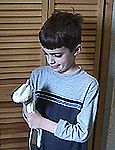
Grades K-12
Here is a simple variation of the Brain Bag/Box of Science project. Get 5 to 7 different socks. Put different small objects into each sock. Have other people try to guess what is inside of each sock by touching and feeling the object on the outside of the sock. If they can't guess what the object is, have them put their hand into the sock and feel it. By actually touching the object, you can get more information about the characteristics of the object. For example, its roughness and texture. Try numbering each sock. Then prepare a worksheet identifying the object in each numbered sock.
Materials:
- 5-7 socks
- Small objects to put into the socks (pencil eraser; coin; golf ball; rock, etc.)
The Braille Alphabet
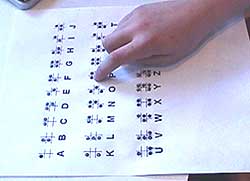
Grades 3-12
The Braille alphabet was invented by Louis Braille to help people who are blind read. The Braille system uses a series of raised dots that people "read" with their fingers. To make your own set of Braille letters, print out this picture on a piece of paper. Place a small dot of white glue on the black dots of each letter. When the glue dries, you will have created large Braille letters. Cut out each letter and try to arrange the letters in alphabetical order using your sense of touch.
Materials:
- Braille Alphabet Sheet
- White glue
Where Was That?
Grades 3-12
With a ball-point pen (or washable marker), touch a location on the skin of a blindfolded person (your subject). A small pen mark should be left behind. While your subject is still blindfolded, give the person a pen of a different color and ask him to touch the point that was just touched by you. Measure the distance from this guessed point to the actual point that was touched.
Questions and Comparisons:
- Try different areas of the body and compare the distances between the actual point and the guessed point.
- What part of the body has the least distance between the actual point and guessed point? Why?
Materials:
- 2 different color ball point pens or washable markers
- Ruler
Finger Reading
Grades 5-12
Our sense of touch is so sensitive that we can read with our fingers. READ WITH OUR FINGERS??? Blind people do - they read with the "Braille" alphabet. Each Braille letter is a series of raised spots. People read Braille by moving their fingers over the letters. Try making some of your own Braille letters. Cut out squares (2 inches by 2 inches) of cork or cardboard. Draw a letter on the square. Now stick the sharp ends of pins into the outline of each letter. Blindfold a subject, then have the subject try to identify the letter by feeling the blunt ends of the pins with just his or her fingertips.
Questions:
- How many pins do you need for successful letter identification? Remove some pins and try it again.
- Is it easier to make an identification if the subject MOVES his or her fingers across the pattern compared to just TOUCHING the pattern?
- Make a short 2-4 letter word with your Braille letters. Can your subject read the word?
Materials:
- Cardboard or thin cork
- Pins - one side should have a small ball or be blunt
- Marker or Pen or Pencil - to draw outline of letters
- Blindfold
- Scissors
Tactile Double Trouble
Grades K-6
How about a little comparison shopping? Collect some small object "pairs" such as two identical bottle caps, two paper clips, two marbles, etc. Put one item from each pair into two separate bags. So now you have one set of objects in one bag and the matching objects in another bag. Reach into the bags and pull out the pairs. To make things harder, use object pairs that are only slightly different from each other, such as grades of sand paper or different sizes of marbles.
Another way to play Double Trouble is to put one set of objects in a bag and have a friend hold up the objects. To play, the friend will hold up the item he or she wants you to find in the bag. See how long it takes to find it.
Materials:
- Object Pairs - marbles, paper clips, sand paper squares, balls, etc.
- Bags- paper bags, pillow cases, brain bags of science
Half Full or Half Empty
Grades 3-12
This experiment is technically not one of the sense of touch....actually, this experiment deals with information sent to the brain from MUSCLES. We usually don't think about where the parts of our body are in space. We just move. However, muscles are constantly feeding information to the brain about what they are doing. To illustrate this, get two identical containers that will hold at least 16 oz (470 ml) of material. Label one container with the letter "A" and the other with the letter "B". Fill each container half way up with exactly the same amount of water (or beans or rice or marbles). Put one container in each hand of a blindfolded subject. The weights should feel the same. Now, add a known amount of water (or beans or rice or marbles) to the container with the letter "A" (to remember, the letter "A" is for "Add"). Give the containers back to the subject and ask if the weights feel the same or different. If the subject says "Different", ask which container is heavier. Is it a right guess? If it is, remove the containers, then place them back on the subject's hands and ask again to make sure it wasn't a lucky guess. If the subject cannot tell the difference between containers or the guess was wrong, add another known amount of material to container "A". Test the subject again until the subject can detect a difference between container weights.
Questions:
- What is the detection threshold? (how much material must be added for a correct detection of difference?)
- What happens if you start with more "baseline" weight? Use 1 gallon milk jugs and see how much material you must add for the correct difference detection. Do you need to add more or less when you start with these large containers?
Materials:
- Containers - make sure they are the same before starting
- Filling material - water or beans or rice or marbles
- Marker to label containers
- Blindfold
Touch Boards
Grades K-3
Here is an easy way to introduce the sense of touch. Cut out square pieces of cardboard. Each square should be about 12 inches (30 cm) by 12 inches (30 cm). Glue on popsicle sticks to divide the cardboard square into sections (or just use a marker). Now in each section, glue on objects that have different textures. For example, feathers, sand, rocks, wood, paper, sandpaper could all be glued into different sections. Everyone's board should be a little different and it is fun to compare the different textures people find. Here is an example touch board:
sand | rock | wood
feather | sandpaper | marble
leaf | string | rice
Materials:
- Cardboard (cut into squares)
- Popsicle sticks (to divide cardboard)
- Items to glue (with different textures)
- Glue
Coin Identification
Grades K-6
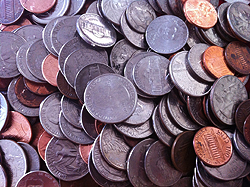
Most countries produce coins of different denominations with different features. For example, the US quarter is larger than the US dime, nickel or penny. Some coins have ridges on their sides while other coins are smooth. These features make it easier for people who are blind or visually impaired to identify their money.
Use your sense of touch to identify the value of different coins? First, get a sense of what different coins feel like by exploring the tops and sides of each coin. Then try these experiments using US coins (coins from other countries should work too).
Experiment 1: Gather nine pennies and one nickel. Mix the coins, then find the nickel without looking at the coins. Try the experiment with other denominations of coins.
Experiment 2: Gather one penny, one nickel, one dime and one quarter. Using your sense of touch only, arrange the coins in order from the least in value to the highest in value.
Materials:
- Pennies
- Nickels
- Dimes
- Quarters
You might wonder why the US dime (10 cents) is smaller than a nickel (5 cents) or penny (1 cent). The answer is that early dimes were made of valuable silver, so they were small.
Active Touch
Grades K-12
Is it easier or harder to identify an object if you move your hands over the object? Get your collection of small objects (or cookie cutters). Have your subject close his or her eyes. Press the object into your subject's hand and ask what it is. Do not have your subject move his or her hand. If your subjects cannot identify the object, let them move their hands over the object and let them explore the object with their fingertips. Now ask them what the object is. Are they better?
Materials:
- Small objects (or cookie cutters or block letters or stencils)
Tactile Mazes
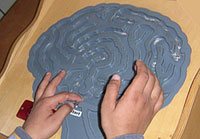
Grades K-6
If you think mazes are hard using your eyes, try one with your eyes closed. To make a tactile maze, apply glue (white glue or glitter glue) to a piece of cardboard. Don't make the pattern too difficult. For an easier maze, let the glue dry and then apply another coat (this will raise the maze and make it easier to feel). After the glue is dry, close your eyes and navigate the maze by holding your finger on the glue. You can share mazes with your friends.
Materials:
- Glue (white glue or glitter glue)
- Cardboard (at least 5 in. x 5 in. square).
A Puzzling Situation
Grades K-6
Jigsaw puzzles are fun, but did you ever try to put one together without looking at it? Get a simple children's puzzle with only 4 to 6 pieces. The best ones are those with a raised rim around the border. Empty the puzzle and try to put it together using only your sense of touch.
Materials:
- Simple jigsaw puzzle
Copyright © 1996-2021, Eric H. Chudler All Rights Reserved.
